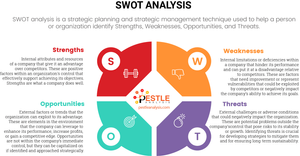Our Under Armour SWOT analysis identifies 10 strengths, 12 weaknesses, 15 opportunities and 12 threats for the sportswear company.
Hailing from Baltimore, USA, Under Armour (started in 1996) is a company that manufactures footwear, sportswear, and casual apparel. It has also created various fitness apps to help people stay healthy.
Under Armour became a multibillion-dollar brand under the leadership of Kevin Plank, the founder and CEO from its inception until 2020, when the COO Patrik Frisk replaced him, only to return as CEO in 2024. The company initially gained recognition for its moisture-wicking performance apparel designed to keep athletes cool and dry during exercise.
Under Armour has had to shut down stores because of the COVID-19 pandemic, which has been a massive blow for them, as it has been for many businesses. As of 2024, Under Armour, Inc. continues to position itself as a major player in the sports apparel and equipment industry.
We’ll work out an Under Armour SWOT analysis to see where it is standing but first, let’s understand what a SWOT analysis actually is.
Lookout; the FBI is after you! Just kidding, no need to get your knickers in a twist; you’re safe.
In a SWOT analysis, the components are divided into internal and external factors. Strengths and weaknesses are considered internal factors because they are inherent to the company itself and can typically be directly managed or influenced by the organization. You can learn everything you need to know about this strategic tool on our dedicated page for SWOT analysis.
Let’s now see where Under Armour falls based on this analysis.
Under Armour Strengths
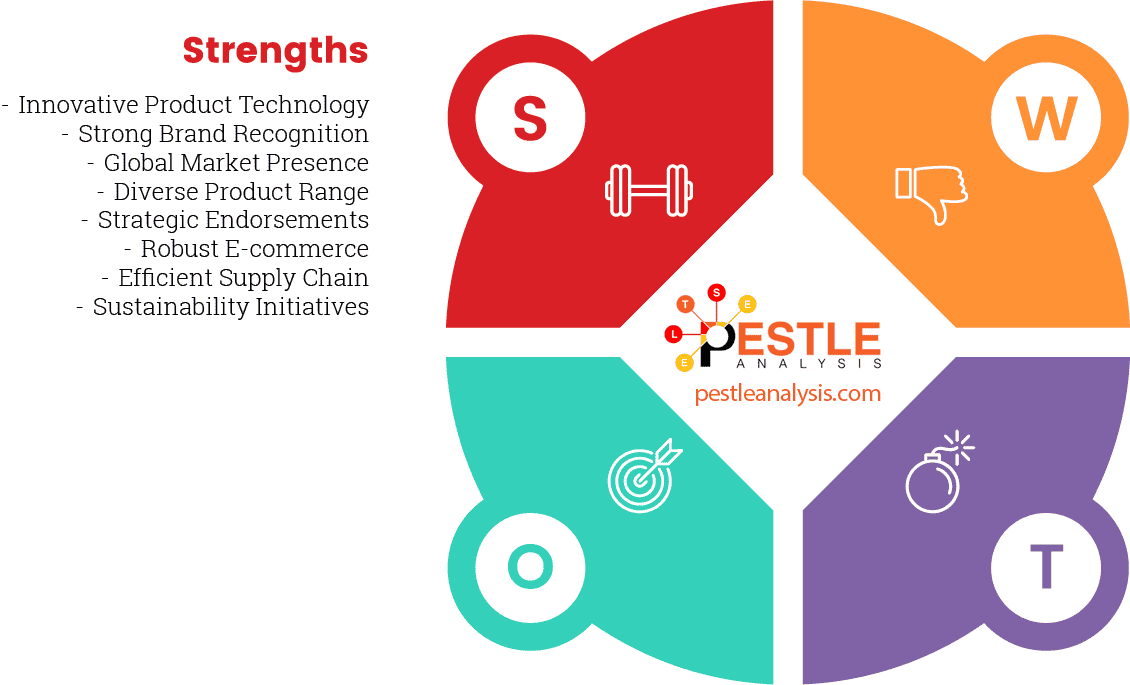
Every SWOT analysis begins with a list of strengths. The strengths below showcase Under Armour's capacity to leverage its brand, innovation, and strategic market moves to maintain a strong position in the competitive sports apparel market.
Brand Recognition and Loyalty
Under Armour has successfully built a strong brand recognized globally for its innovation in performance apparel. The brand loyalty is evident in its consistent customer base, particularly among athletes.
Innovative Products
Innovation is a core strength, with the company regularly introducing new fabrics and technologies, like their moisture-wicking fabric and HeatGear clothing lines, which keep athletes dry and comfortable during workouts.
We have a strong appreciation for Under Armour's marketing strategies, which always stand out from the clutter. The core strength of this brand is the revolutionary T-shirts they manufacture, which are comfortable, light, and very resistant to sweat, perfect for athletic people who like to stay fit.
Diverse Product Range
Under Armour offers a broad array of products, including sports gear, footwear, and casual apparel, which appeals to a wide demographic, from professional athletes to casual gym-goers.
Strong Celebrity Endorsements
The company has a strong roster of endorsements from high-profile athletes and celebrities, which enhances its visibility and appeal.
Strategic Partnerships and Sponsorships
Under Armour has secured key partnerships with sports teams and educational institutions, which not only broadens its market reach but also solidifies its status in the athletic community.
Global Presence
The coolest thing about the brand is that it has managed to have a global presence with its key locations in North America, Asia Pacific, EMEA, and Latin America. With operations in numerous countries, Under Armour has a substantial international market presence that helps diversify its revenue streams and reduces dependence on any single market.
E-commerce Strength
The company has a robust e-commerce platform that complements its brick-and-mortar stores, making its products easily accessible worldwide.
Supply Chain Efficiency
The Under Armour business model has managed to survive and prosper amongst competition because of the brand’s diverse distribution channels, portfolio, and exceptional quality clothing.
Under Armour has developed an effective and responsive supply chain, which helps in minimizing costs and adapting quickly to market changes.
Community and Social Engagement
They actively engage in community initiatives and sports programs, which boosts their brand image and customer loyalty.
Commitment to Sustainability
Increasing focus on sustainability, with initiatives aimed at reducing environmental impact and promoting sustainable practices, aligns with the growing consumer preference for eco-friendly products.
These strengths have eventually paved the way for Under Armour to be a step ahead of the competition in the sports apparel industry. Now that the company has gone digital by creating its fitness apps, it can claim to be the biggest fitness company globally.
Under Armour Weaknesses

Identifying weaknesses in Under Armour's business strategy and operations provides insights into areas where the company might be vulnerable or lagging behind its competitors. Moving to the second section of our SWOT analysis, here are twelve weaknesses that Under Armour might be facing:
High Dependence on North American Market
Despite its global presence, a significant portion of Under Armour’s revenue is still heavily reliant on North American sales, exposing it to risks from regional economic downturns.
Limited Diversification
Compared to competitors like Nike and Adidas, Under Armour has less diversification in sports offerings and lifestyle products, which can limit market appeal. Whereas the Under Armour target market consists of both men and women, they don’t seem to be the number one choice for women athletes. There aren’t many options to customize Under Armour apparel and accessories, either.
Inventory Management Issues
Under Armour has faced challenges with excess inventory in the past, which can lead to increased operational costs and reduced profitability due to markdowns.
Pricing Strategy
The brand is positioned as a premium sports apparel provider, which might limit its customer base, particularly in cost-sensitive markets.
Intense Competition
Under Armour faces fierce competition from established brands like Nike, Adidas, and newer entrants, which consistently pressure its market share and pricing.
Weak Performance in Footwear
Although Under Armour has expanded into footwear, it has struggled to gain a significant market share compared to its apparel products, partially due to lower consumer ratings on performance and style.
Supply Chain Complexity
Global supply chain disruptions have exposed vulnerabilities in Under Armour’s logistics and distribution strategies, impacting its ability to meet demand efficiently.
Inconsistent Quality Across Product Lines
There have been occasional complaints about inconsistent quality and durability in some product lines, which can hurt the brand’s reputation.
Retail Store Performance
The physical retail sector, where Under Armour has significant investments, is increasingly challenging with high operational costs and shifting consumer preferences towards online shopping. They already had fewer physical stores worldwide, to begin with, compared to competitors such as Nike, but this recent pandemic has made things much worse for the company.
Marketing Missteps
Some of Under Armour’s marketing campaigns have faced criticism for not resonating well with target audiences, reflecting a potential misalignment with market dynamics and consumer preferences.
Management Turnover
The company has experienced significant executive turnover in recent years, which can lead to strategic inconsistency and hinder long-term planning.
Data Security Concerns
Like many retailers, Under Armour has faced issues with data security, specifically a significant data breach in its MyFitnessPal app, which can undermine consumer trust.
Under Armour Opportunities
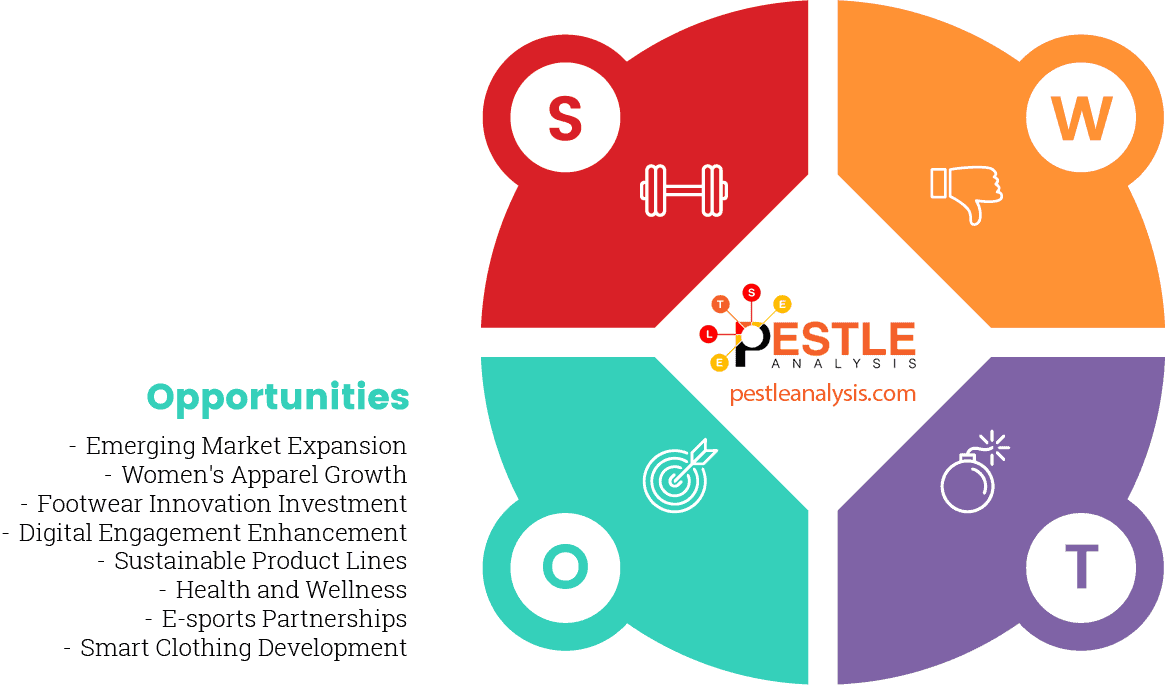
Under Armour has several opportunities to leverage for growth and improvement. As we move to the third part of our SWOT analysis, here's a detailed look at 15 opportunities that could be impactful for their strategy:
Expanding Global Footprint
By increasing its presence in emerging markets like Asia and Latin America, Under Armour can tap into new customer bases and reduce its dependency on the North American market.
Women's and Kids' Athletic Wear
The market for women's sports apparel and athleisure is growing. Under Armour could expand its offerings in this segment to meet the rising demand. They can also work on marketing strategies to attract female consumers to whom they cater but somehow don’t appeal to, not as much as they could, at least.
The Under Armour target market can easily be expanded to include a kid’s range, too. They also can diversify their product line and venture out into different types of sports to grow even further.
Sustainable Products
Increasing consumer awareness and demand for eco-friendly products present an opportunity for Under Armour to innovate and lead in sustainable sports apparel.
Footwear Innovation
Investing in research and development to enhance the performance and style of its footwear line could help Under Armour capture more of this lucrative market.
Digital Transformation
Enhancing digital platforms for a better customer experience and integrating advanced technologies like AI for personalized products and services can boost sales and customer loyalty.
Health and Wellness Trend
Capitalizing on the growing trend towards health and fitness, Under Armour can offer more health-oriented products or services, such as fitness apps or wellness programs.
Strategic Acquisitions
Acquiring smaller brands or startups with innovative technologies or products could allow Under Armour to broaden its product line and access new markets.
Partnerships with Esports
The esports industry is rapidly growing. Under Armour could forge partnerships with esports teams or tournaments to market its products to a younger, tech-savvy audience.
Augmented Reality Shopping
Implementing AR in shopping apps to allow customers to try products virtually could enhance the online shopping experience and increase sales.
Collaborations with Designers
Limited edition collaborations with well-known designers or celebrities could generate buzz and appeal to a broader consumer base.
Expansion into Lifestyle Apparel
Broadening its product range to include more casual and work-from-home apparel could capture more of the everyday wear market.
Smart Clothing Technology
Investing in the development of smart clothing that can track health metrics could position Under Armour at the forefront of technological innovation in sportswear.
Increased Focus on Retail Experience
Revamping retail stores to offer unique in-store experiences can attract more foot traffic and enhance brand loyalty.
Community and Sports Programs
Increasing involvement in community sports programs and school partnerships can improve brand visibility and foster customer loyalty from a young age.
Leveraging Social Media
Enhancing social media engagement and influencer partnerships can effectively reach and engage with the younger demographics. The “fit” lifestyle is becoming more and more popular with each day, so it is an industry full of potential for Under Armour. With fitness enthusiasts and influencers increasing daily all over social media, the fitness world continues to grow without any plans of stopping.
Under Armour Threats
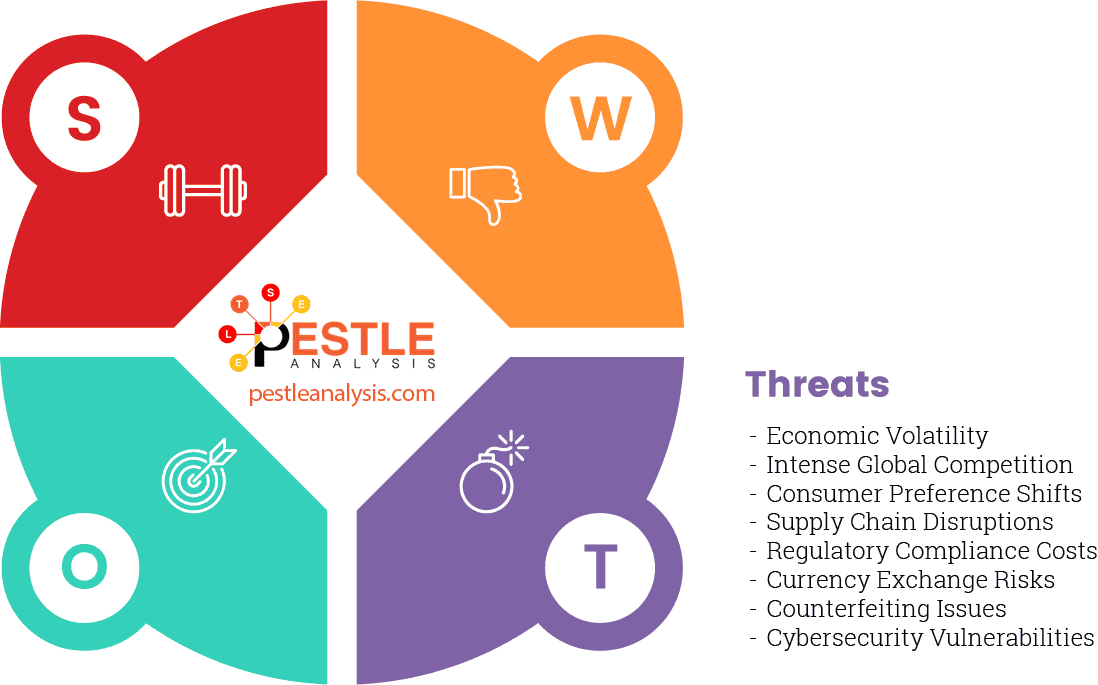
In the context of a SWOT analysis, recognizing potential threats is crucial for Under Armour to proactively mitigate risks. In the final section of our SWOT analysis, here are twelve significant threats that the company may face:
Intense Market Competition
Under Armour competes with larger, more established brands such as Nike and Adidas, which have greater resources for marketing, innovation, and global presence. Their core competency of sweat-proof T-shirts is no longer specific only to this brand; the competition has caught up, and this type of design in apparel is available in other brands, often at better prices too.
Economic Downturns
Global economic instability, like recessions, can reduce consumer spending on sporting goods and apparel, impacting Under Armour's sales.
Currency Fluctuations
As a global retailer, fluctuations in currency exchange rates can affect profitability and pricing structures in international markets.
Counterfeiting
The presence of counterfeit products can harm Under Armour’s brand reputation and reduce its market share.
Changes in Consumer Preferences
The sportswear industry is trend-sensitive; a shift in consumer preferences away from Under Armour’s core product offerings can lead to reduced sales.
Supply Chain Disruptions
Events like natural disasters, pandemics, or political instability affecting countries where Under Armour manufactures its products can disrupt supply chains.
Regulatory Changes
New regulations related to trade tariffs, import-export controls, and manufacturing standards can increase costs or limit market access.
Technological Disruptions
Failure to keep up with technological advancements in product development and consumer engagement could leave Under Armour behind its competitors.
Retail Channel Disruptions
The shift towards online shopping can threaten Under Armour's physical retail business model, necessitating higher investments in digital transformation.
Data Security Risks
As Under Armour expands its digital footprint, it becomes more susceptible to cybersecurity threats, which can compromise consumer data and trust.
Labor Practices Scrutiny
Like many global brands, Under Armour could face scrutiny and reputational damage over labor practices in its supply chain if not managed ethically.
Health and Fitness Trends
Changes in health and fitness trends can impact the demand for specific types of apparel and equipment, potentially disadvantaging Under Armour if it fails to align with these trends.
4 Recommendations based on our Under Armour SWOT Analysis
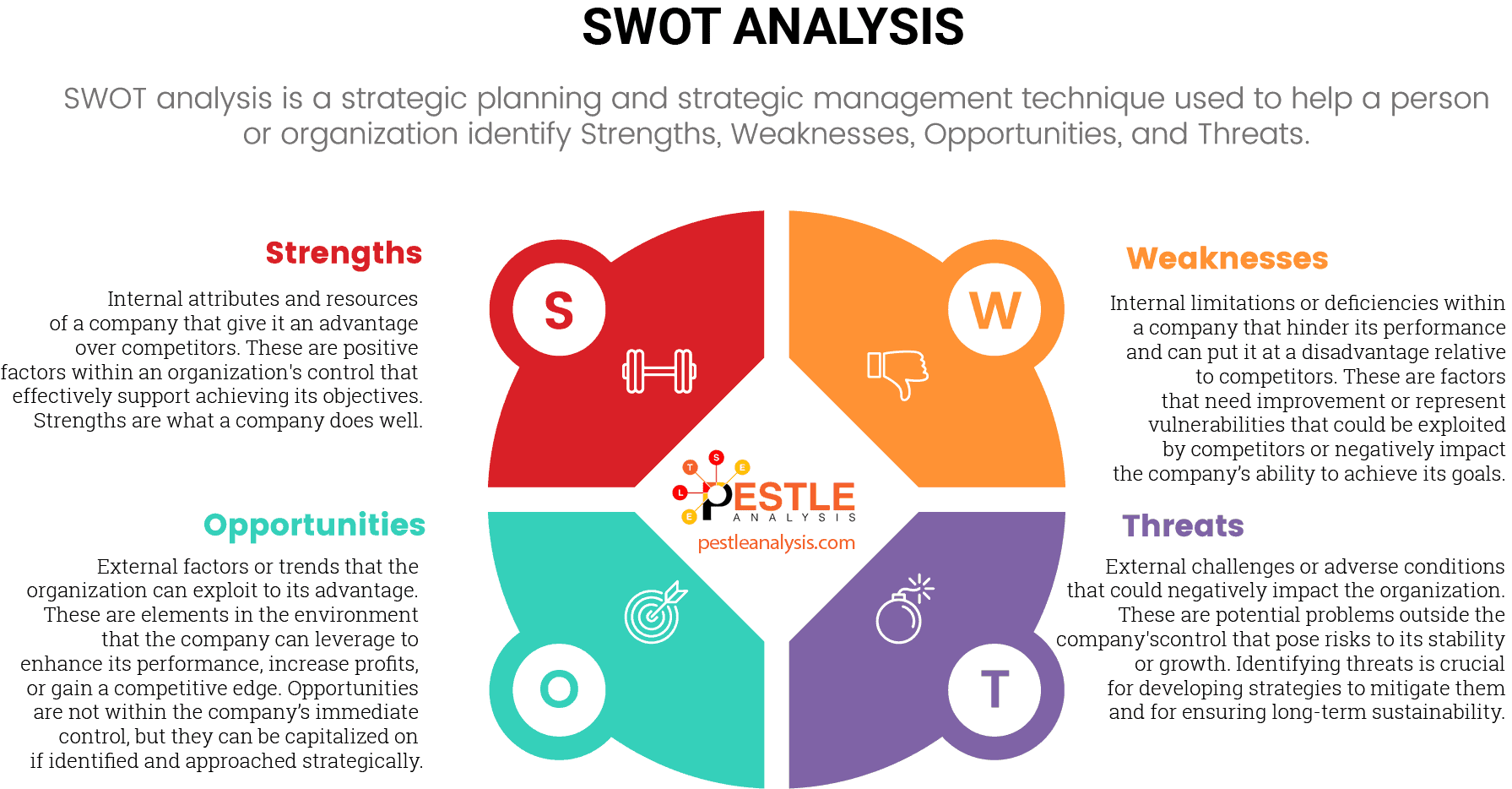
Under Armour has been a player in the sports industry for decades now, and they have seen a very long period of constant highs.
Based on the comprehensive SWOT analysis of Under Armour, here are four strategic recommendations that could help the company build on its current strengths, address pressing weaknesses, seize new opportunities, and better prepare for potential threats:
- Enhance Global Market Diversification: To reduce its dependency on the North American market and mitigate risks associated with economic fluctuations, Under Armour should aggressively expand its footprint in emerging markets. This could involve localized marketing strategies, partnerships with local athletes, and expanding distribution channels to cater to regional tastes and preferences. This approach not only spreads risk but also taps into new revenue streams. According to reports, Under Armour's international segment more than doubled over a four-year period in late 2023!
- Invest in Footwear and Women’s Segments: Given the opportunities in the growing markets for women's sports apparel and footwear, Under Armour should focus on diversifying and enhancing its product offerings in these categories. This could involve investing in targeted marketing campaigns, collaborating with fashion influencers, and prioritizing research and development to innovate products that meet specific demands in these segments.
- Accelerate Digital Transformation and E-commerce Initiatives: To address the shift towards online shopping and compete effectively with rivals who are advanced in digital capabilities, Under Armour should enhance its e-commerce platforms. Improving user experience, employing advanced data analytics to personalize marketing efforts, and integrating augmented reality features to try products virtually can enhance online consumer engagement and sales.
- Strengthen Supply Chain Resilience and Sustainability Practices: In response to threats from supply chain disruptions and increasing consumer demand for sustainable products, Under Armour should invest in making its supply chain more resilient and environmentally friendly. This could include diversifying manufacturing locations, investing in sustainable materials and processes, and enhancing transparency in labor practices. Such initiatives can also serve as a marketing tool to boost the brand's image among eco-conscious consumers.
This proactive approach will support the company's long-term growth and stability in the competitive sportswear market.
Despite the potential threats faced by them, especially in light of the pandemic, we believe Under Armour still has the potential of becoming a key competitor for other similar brands, provided they play on their strengths and divulge into the opportunities effectively.
Having now completed the SWOT analysis of Under Armour, here is the analysis of Under Armour's competitors we have conducted here at PESTLEanalysis:
- SWOT analysis of Nike
- SWOT analysis of Puma
- SWOT analysis of Adidas
- SWOT analysis of Lululemon
- PESTLE analysis of the sportswear industry

